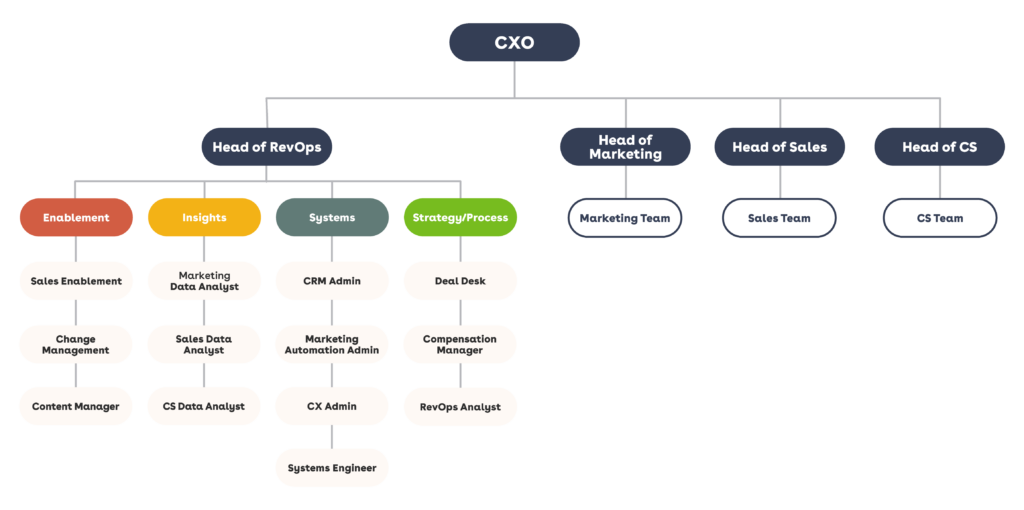Designing a RevOps Org
RevOps is one of the most strategic functions in GTM organizations. We sit at the intersection of data, systems, and process after all. Shaping how decisions are made and how efficiently revenue is generated. If I was a CRO, one of the very first things I would do is make a hire for my right hand, the RevOps leader.
Indulge me with a soapbox moment for a minute. Without a structured or intentional RevOps team, the business will have process overlaps, process gaps, unreliable data, and a propensity to make decisions on little more than intuition. Not only that, but your marketing, sales, and CS leaders will do their best to align but often will lean on the CRO as a backstop. Why not bring in the glue guy/gal upfront?
Organization design is not about creating reporting lines or titles. It’s about defining how work flows across the revenue engine. The right structure ensures accountability, transparency, and collaboration. It creates a unified view of how leads convert to revenue and how teams contribute to growth.
I’ll do my best to break down how to design a high impact Revenue Operations organization that can scale with your business.
Let’s get into it!
The Purpose of Organization Design in RevOps
Most companies invest heavily in systems and tools BEFORE they understand how the work is meant to flow. They hear their peers using such and such a tool. They come across something on LinkedIn. A new CRM or automation platform cannot fix a broken process. Structure comes first. Don’t fall victim to Shiny Object Syndrome (S.O.S.).
Organization design establishes clarity. It defines who is responsible for what, how decisions are made, and where data is managed. It aligns your strategy with execution.
For RevOps, this means answering questions like:
Who owns forecasting and pipeline visibility?
Who defines and manages the lead lifecycle?
Who governs the CRM schema, rules of engagement, and reporting layer?
How does RevOps support both inbound and outbound motions?
What outcomes is the team measured on?
The purpose of design is to ensure that every GTM team operates with the same inputs, definitions, and accountability. A clear design supports credibility. When RevOps operates as a strategic partner instead of an order taker, it earns trust from Sales, Marketing, and Customer Success. Leadership relies on RevOps to guide investment decisions, territory models, and planning cycles.
Every effective design starts with the mission and scope. But what does that even mean?
Defining the Mission and Scope of RevOps
Before building a structure, define why your RevOps organization exists. The mission must be explicit.
A clear mission statement might read (and yeah feel free to steal the one below):
“Revenue Operations enables predictable growth through data, process, and systems that align Marketing, Sales, and Customer Success.”
That statement tells the organization what RevOps owns and how it creates value. But go ahead and create your own!
Scope determines the boundaries of work. Without it, RevOps becomes a catch all. Instead of the glue guy/gal you can quickly become the fall guy/gal. Operators end up managing campaign requests, one off reporting, and internal tooling with no prioritization framework.
To define scope, outline what RevOps owns, influences, and supports
This framework prevents confusion. It also helps leadership allocate headcount properly across core functions. Scope may evolve with maturity.
Early stage companies often rely on one or two generalists who manage systems, reporting, and process
As the company grows, specialization becomes necessary.
A centralized team can no longer handle every tactical request while also driving strategy. Start narrow and grow deliberately. Scope creep is one of the biggest threats to RevOps efficiency… and your sanity!
Choosing the Right Operating Model
The structure of RevOps determines how effectively it can serve the GTM organization. There are three common operating models:
Centralized
Hub-and-spoke
Decentralized
Centralized Model
All RevOps resources report into one leader, often under the Chief Revenue Officer or Chief Operating Officer.
When it works:
This model fits early- to mid-stage companies that need control and consistency. It allows for unified data governance and aligned processes.
Benefits:
Single source of truth
Clear ownership
Efficient prioritization of projects
Tradeoffs:
May create bottlenecks for requests from Marketing or Customer Success
Can feel detached from day-to-day functional needs
Centralization is effective when the business still operates under one GTM motion or region. Once complexity increases, this model can become rigid.
Hub-and-Spoke Model
A core RevOps team (the hub) manages shared systems, data, and analytics. Dedicated analysts or operations managers (the spokes) embed within functional teams like Sales, Marketing, and Customer Success.
When it works:
This model fits mid-market or enterprise organizations with mature GTM departments. It balances consistency with flexibility.
Benefits:
Shared data standards with tailored support
Better alignment between RevOps and departmental goals
Faster response time for specialized needs
Trade-offs:
Risk of duplicate tools or processes if not governed well
Requires clear prioritization frameworks between hub and spokes
This model scales well once GTM headcount exceeds 100. It enables RevOps to act as both strategist and service provider.
Decentralized Model
Each GTM department manages its own operations function. RevOps becomes a coordination forum rather than a unified team.
When it works:
Only viable for very large enterprises or holding groups where divisions operate independently.
Benefits:
Deep specialization within each function
Maximum autonomy
Trade-offs:
Fragmented data and inconsistent metrics
High cost and complexity to coordinate
Decentralization is rarely ideal for high growth SaaS or B2B companies. Most successful organizations operate within a centralized or hub-and-spoke structure.
Designing Around Core Capabilities
Instead of designing the org chart around job titles, design it around capabilities. Titles evolve, but capabilities define what the team can deliver.
Four capabilities form the backbone of a strong RevOps organization:
Systems and Enablement
Manage the technology stack across CRM, marketing automation, and customer success platforms.
Maintain data flows, integrations, and user permissions.
Lead implementation of new tools and ensure adoption.
Example roles: Salesforce Administrator, Marketing Automation Manager, Enablement Specialist.
Process and Planning
Define and document GTM processes from lead handoff to renewal.
Support annual and quarterly planning, territory design, and quota allocation.
Own forecasting and pipeline management frameworks.
Example roles: Sales Operations Manager, GTM Strategy Lead, Business Planning Analyst.
Data and Insights
Create dashboards and reporting frameworks.
Ensure data accuracy, manage enrichment pipelines, and define metrics.
Support revenue analytics and predictive modeling.
Example roles: BI Analyst, Data Engineer, Analytics Manager.
Execution and Enablement
Develop playbooks, training programs, and change management plans.
Translate insights into actions that improve sales productivity.
Example roles: Sales Enablement Manager, Program Manager, GTM Readiness Lead.
Each capability should have clear goals and a defined relationship with other functions. For example, Data and Insights may provide reporting on pipeline velocity, which informs Process and Planning to adjust forecasting methodology. Systems and Enablement ensures that the required fields exist in the CRM. Execution and Enablement then trains the sales team on the updated process.
This alignment creates a continuous improvement loop instead of isolated projects.
Clarifying Ownership and Accountability
The most common friction in RevOps occurs when multiple teams claim partial ownership of the same process. Forecasting, lead routing, and territory assignments often become gray areas.
Accountability requires clear decision rights. A simple RACI matrix can define who is Responsible, Accountable, Consulted, and Informed for each domain.
Once ownership is clear, governance becomes easier. Issues like forecast bias or lead leakage can be resolved quickly because the escalation path is known.
Accountability also supports transparency. Leaders can review performance metrics by function and identify process gaps without political friction.
Building Cross-Functional Alignment
RevOps exists to connect the dots across functions. To succeed, it must build formal interfaces/interlocks with other teams, namely:
Finance
Finance and RevOps share a tight relationship. Finance relies on RevOps for bookings data, ARR reporting, and commission accuracy. RevOps relies on Finance for budgets, headcount forecasts, and revenue recognition rules.
Create a monthly sync to align financial actuals with CRM data. Ensure the revenue model in Salesforce or HubSpot reconciles with the general ledger.
Product
For product-led growth models, RevOps integrates usage data into GTM systems. This enables lead scoring, account health tracking, and expansion forecasting.
Define a shared taxonomy for users, accounts, and product events. Without this, the business cannot tie product adoption to revenue outcomes.
IT and Data Engineering
These teams manage infrastructure, security, and data warehousing. RevOps should act as a stakeholder in data governance councils.
Align on data pipelines, access controls, and integration schedules. This ensures accuracy and compliance across the tech stack.
People Operations
RevOps and People Ops collaborate on enablement, performance tracking, and territory assignment. For example, when a new AE joins, People Ops triggers onboarding, while RevOps assigns quota, territory, and CRM access. When someone exits the company, RevOps works to offboard in GTM systems. If they’re a sales rep then working on reallocating accounts, contacts, and opportunities as well.
Communication Frameworks
Define a cadence for collaboration:
Weekly: Pipeline review, forecast calls, tactical system syncs
Monthly: Business review, data governance meeting
Quarterly: Planning and territory adjustments
Annually: Strategic planning and system roadmap
These forums create rhythm and predictability. They also reduce the number of ad hoc requests RevOps receives.
Scaling Through Stages of Growth
The design of RevOps must evolve as the company scales. What works at Series A will break by Series C
Seed to Series A: Generalist Phase
If you’re slammed in your RevOps or want to level up; check out the RevOps Impact Offerings
1/ Subscribe: Youtube Spotify Apple
2/ Join 300+ alumni.
RevOps Impact Course | Sales Ops Masterclass
3/ 1-on-1 RevOps Coaching with me. Let me help you push through the ceiling
4/ Your a business and need strategic fractional consulting or advisory
Keep reading with a 7-day free trial
Subscribe to RevOps Impact Newsletter to keep reading this post and get 7 days of free access to the full post archives.







